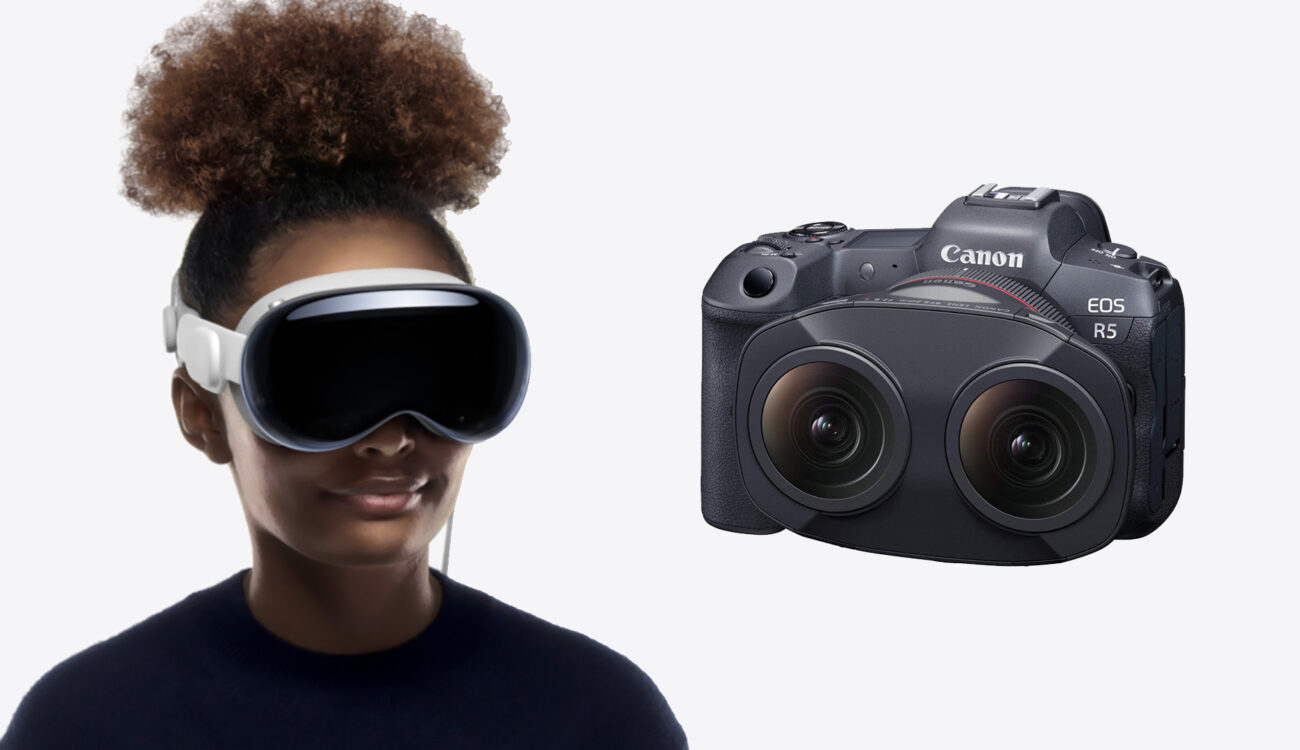
Canon’s latest firmware and software updates let three EOS dual-fisheye lenses export Apple Projected Media Profile (APMP) video and Spatial Photo files—giving Vision Pro users an affordable path to stereoscopic 8K-container (≈4K-per-eye) content and signaling an even closer Canon-Apple partnership. Canon EOS VR System goes Vision Pro – let’s learn more.
Canon’s newest announcement pulls its EOS VR System firmly into Apple’s ecosystem. As of June 2025, Canon’s dual-fisheye lenses and software can natively produce media in Vision Pro formats. The full-frame RF5.2 mm F2.8 L Dual Fisheye and APS-C RF-S 3.9 mm F3.5 STM Dual Fisheye now output APMP video, while the RF-S 7.8 mm F4 STM Dual handles Apple’s new Spatial Photo still format. Free firmware updates and a refreshed mac-only EOS VR Utility let creators convert captured 3D footage straight into Vision Pro-ready files.
 Canon’s EOS R5 with the RF5.2mm F2.8 L Dual Fisheye lens. Canon’s VR system can now export Vision Pro–compatible APMP video (90 fps 8K‑per‑eye stereo) and Spatial Photo content for immersive playback . Image credit: Canon
Canon’s EOS R5 with the RF5.2mm F2.8 L Dual Fisheye lens. Canon’s VR system can now export Vision Pro–compatible APMP video (90 fps 8K‑per‑eye stereo) and Spatial Photo content for immersive playback . Image credit: Canon
At WWDC 2025, Apple introduced visionOS 26 with built-in APMP and Spatial Photo support. Canon’s update arrived in tandem: EOS VR Utility now converts 180° stereoscopic footage (8 192 × 4 096 frame, ~4 096 × 4 096 per eye) into APMP QuickTime files viewable in Apple’s native player. Spatial-photo export already works on the EOS R7 and new R50 V (May 2025) with the RF-S 7.8 Dual, and a July 2025 firmware patch will extend the feature to the entry-level EOS R50. Canon details the rollout in its June 10 press release.
*Prices may vary by region and retailer.
All three lenses project two fisheye images onto a single sensor, simplifying 3D capture. EOS VR Utility stitches, encodes depth, and now exports APMP (video) or Spatial Photo (still) files – turning a familiar EOS body into a Vision Pro camera.
Competing 3D Solutions
Blackmagic URSA Cine Immersive 8K. The dedicated URSA Cine Immersive uses dual 12 K sensors to deliver true 8K-per-eye at up to 90 fps, supposedly already shipping (?) for about $29,995.
Apple’s prototype 8K stereo camera. Shown in internal Vision Pro productions but not commercially available. It was used on the “Submerged” short available on Vision Pro – here’s our report.
Canon’s workflow. Relies on existing EOS bodies—creators just add a dual-fisheye lens and run the updated Utility, dramatically lowering the cost, albeit at 4K-per-eye resolution.
CineD has tracked these developments in our URSA Immersive hands-on and broader immersive coverage. Canon’s update shifts the cost–benefit equation: many users can upgrade firmware, add a lens, and deliver Vision Pro content without new cameras.
 Canon announces a new dual fisheye lens for VR applications on APS-C cameras. the lens is currently compatible with the EOS-R7. Image credit: CanonWill 3D VR / immersive content become more mainstream?
Canon announces a new dual fisheye lens for VR applications on APS-C cameras. the lens is currently compatible with the EOS-R7. Image credit: CanonWill 3D VR / immersive content become more mainstream?
Apple’s adoption of APMP and Spatial Photo files in visionOS 26 underscores a push to mainstream 3D VR. Canon’s collaboration positions its EOS lineup as the most approachable capture option for Vision Pro storytellers. High-end rigs like Blackmagic’s URSA Immersive and Apple’s own camera will serve premium productions, but Canon now offers one of the easiest routes to quality Vision Pro media—likely spurring more immersive stories for audiences hungry for deeper, more engaging experiences.
Check out our recent coverage of the immersive production “D-Day: The Camera Soldier” for Vision Pro in an interview with producer Victor Agulhon from TARGO, as well as our video interview with Blackmagic Design about the URSA Cine Immersive.
Will Canon’s deeper alliance with Apple be the catalyst that finally brings immersive storytelling into the mainstream, and we’ll be covering every step of the journey. What do you think—will this move push more creators toward Vision Pro production? Let us know in the comments below!
